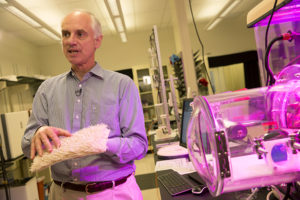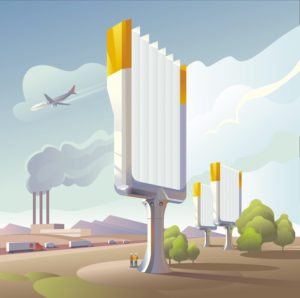I clearly remember the autumn day in 2013 I walked into lab at the Lenfest Center for Sustainable Energy (LCSE) – where I had just picked up an internship during my graduate program in Environmental Science and Policy at Columbia University – with the task of gathering updates to put into the annual report. My first task was to learn about advancements in a new technology that was being developed in that lab that could passively extract carbon dioxide from the atmosphere – aka direct air capture. This material captured CO2 when dry, and released it when moist, using only evaporation to regenerate. Understanding the critical need to treat excess CO2 in the atmosphere with the most environmentally benign, low energy cost, and scalable solution, I decided to bite my teeth into learning all that I could about this bleeding edge invention that might be necessary in the future (and then work backwards into pragmatic solutions that make money today).

Dr. Klaus Lackner holding sheet of material that can passively extract CO2 form the atmosphere
In September 2014, I moved with former LCSE director Klaus Lackner and direct air capture pioneer as chief strategist to help establish the Center for Negative Carbon Emissions at Arizona State University. As a fundraiser and marketer for a new technology effort trying to build a backstop for solving climate change, I frequently found myself articulating an answer to the question: what does removing and sequestering CO2 from the atmosphere have to do with energy systems?
It really comes down to this:
81% of our energy comes from burning fossil fuels and emit carbon dixoide- half of which accumulates in the atmosphere. Ultimately, that makes dealing with climate change a stock problem, not a flow problem. Even if the world is successful at completely switching to carbon free and renewable sources of energy, we are still on a path to overshoot the total allowable concentrations of CO2. Therefore, the ability to capture, and permanently sequester carbon dioxide from the atmosphere as a technical fix – i.e., if we need more machines, we can just build them – has several advantages (for a world that wants to solve climate

An artist’s rendering of what a potential direct air capture device could look like
change):
- Capturing and permanently sequestering carbon dioxide at a limitless scale allows for a price on carbon emissions that can leave no exceptions for emitters to not decarbonize allowing the world to deal with shutting off the most difficult to decarbonize sources of emissions (most inexpensive path to reach necessary targets)
- Unlike biomass, which may only be a temporary carbon sink, direct air capture can unambiguously quantify the amount of CO2 removed therefore allowing for effective trading options
- Assuming we reach an energy utopia (i.e. a carbon neutral future) and need to mechanically draw down the amount of CO2 in the atmosphere, direct air capture can be used as a backstop
- Direct air capture enables the continuation of using hydrocarbons in a fossil free economy by extracting the source of carbon from the atmosphere to make fuels
A number direct air capture start-up companies who are competing for the Virgin Earth Challenge are trying to find a foothold in a world that doesn’t fully value the carbon externality that may indeed wish to be part of the long term vision spell out above. The jury is still out as to whether that may happen, but here is a secret master plan with some strategies they may want to try out.
___
Have comments for the author or ideas for future articles you’d like to see him write about? Contact cj@nyenergyweek.com
 Christophe Jospe is a policy wonk who tries to think like an engineer and investment banker. He is on a quest to unleash funding and amplify attention to the most promising solutions to manage carbon. He holds a BA in Political Science from Colgate University and an MPA in Environmental Science and Policy from Columbia University.
Christophe Jospe is a policy wonk who tries to think like an engineer and investment banker. He is on a quest to unleash funding and amplify attention to the most promising solutions to manage carbon. He holds a BA in Political Science from Colgate University and an MPA in Environmental Science and Policy from Columbia University.

